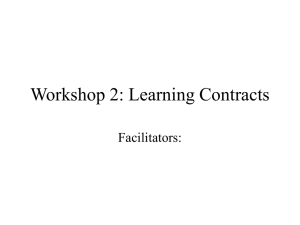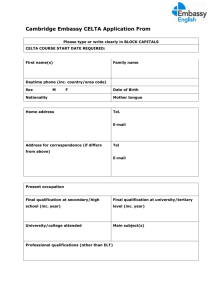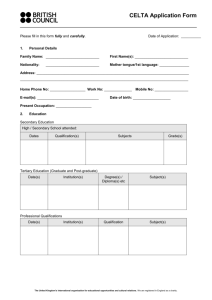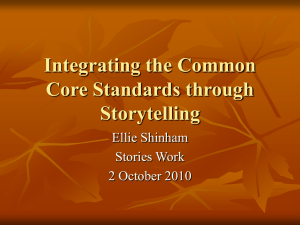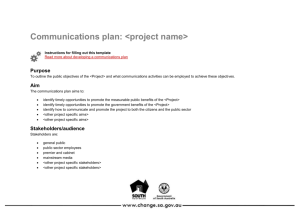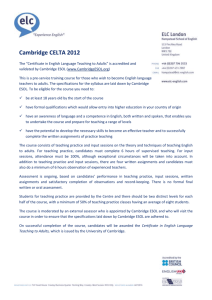Reflective Teaching in Second Language Classrooms
advertisement
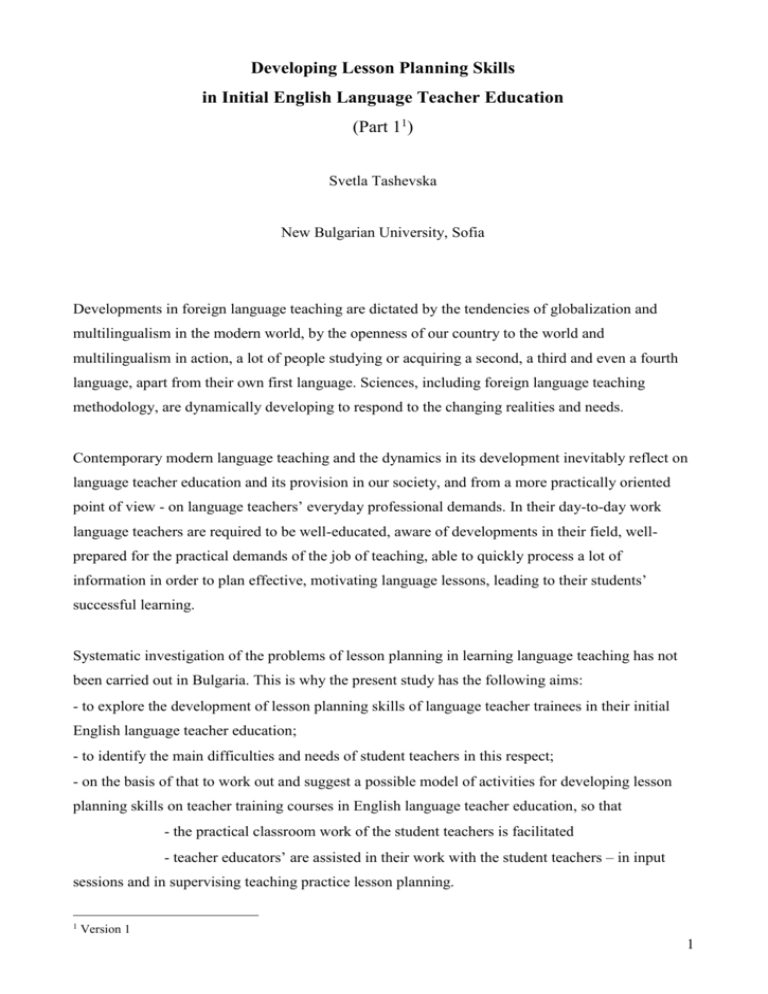
Developing Lesson Planning Skills in Initial English Language Teacher Education (Part 11) Svetla Tashevska New Bulgarian University, Sofia Developments in foreign language teaching are dictated by the tendencies of globalization and multilingualism in the modern world, by the openness of our country to the world and multilingualism in action, a lot of people studying or acquiring a second, a third and even a fourth language, apart from their own first language. Sciences, including foreign language teaching methodology, are dynamically developing to respond to the changing realities and needs. Contemporary modern language teaching and the dynamics in its development inevitably reflect on language teacher education and its provision in our society, and from a more practically oriented point of view - on language teachers’ everyday professional demands. In their day-to-day work language teachers are required to be well-educated, aware of developments in their field, wellprepared for the practical demands of the job of teaching, able to quickly process a lot of information in order to plan effective, motivating language lessons, leading to their students’ successful learning. Systematic investigation of the problems of lesson planning in learning language teaching has not been carried out in Bulgaria. This is why the present study has the following aims: - to explore the development of lesson planning skills of language teacher trainees in their initial English language teacher education; - to identify the main difficulties and needs of student teachers in this respect; - on the basis of that to work out and suggest a possible model of activities for developing lesson planning skills on teacher training courses in English language teacher education, so that - the practical classroom work of the student teachers is facilitated - teacher educators’ are assisted in their work with the student teachers – in input sessions and in supervising teaching practice lesson planning. 1 Version 1 1 In order to identify the problems student teachers experience in lesson planning, the following steps were undertaken. Questionnaires have been delivered to trainees on short English language teacher training courses to register their own perceptions of difficulties and the results are discussed further on. Lesson plans from teaching practice have been analysed to identify the problems student teachers experience when they start planning for their own English lessons. The main problems seemed to be with defining and formulating lesson and activity aims, so these are discussed separately in this paper. Some of the problems could be attributed to the kind of motivation the student teachers bring to their language teacher education, so motivation of some of the teacher trainees has also been investigated and the findings duly presented and discussed. Investigating teacher trainees’ perceptions of their problems in lesson planning The author’s experience shows that many beginning language teachers encounter difficulties when planning their lessons. Some of these difficulties are immediately evident in the lesson plans teacher trainees keep in their learning teaching portfolios, which is a requirement in many teaching qualification programmes. Some of the questions, which logically arise, are whether trainees are aware of their difficulties and needs in this area, so that they can start overcoming their problems, in order to continue developing in the teaching profession. The aims of the following lines are to report the results of a survey conducted into teacher trainees’ perceptions of their own strengths and difficulties in lesson planning during teaching practice on intensive teacher training courses. The data was collected during Cambridge CELTA training in Sofia. On the basis of interpretation of the results relating to the difficulties, implications for further work in the area are considered. The context of the study The participants in this survey are twenty three teacher trainees and their teaching practice tutors from three five-week intensive initial teacher training courses, run within one year (August 2007 March 2008) in Sofia. Cambridge Certificate of English Language Teaching to Adults (CELTA) is a Certificate in teaching English to speakers of other languages. The qualification course is introductory and is aimed at people with little or no previous experience on English language teaching (ELT), or some experience but little previous training. The participants in the courses under investigation were no exception - some candidates with relatively long teaching experience, as well as others, entirely new to the profession. 2 The syllabus, set by Cambridge ESOL, incorporates work in five course units, where, among dealing with learners and teachers, language analysis, language skills - reading, listening, speaking and writing, and developing teaching skills and professionalism, there is a separate unit, 4 Planning and resources for different teaching contexts, with its own requirements. The overall assessment aims, which Cambridge ESOL (2007: 3) stipulates for Unit 4, are: Candidates should be able to: plan and prepare lessons designed to develop their learners’ overall language competence. To ensure achieving this, the syllabus (2007:7) requires work on the following: 4.1 Principles of planning; 4.2 Lesson planning for effective teaching of adult learners of English; 4.3 Evaluation of lesson planning; 4.4 The selection, adaptation and evaluation of materials and resources in planning; 4.5 Knowledge of commercially produced and non-published materials and classroom resources. The course programme, developed by the individual centre, provides for work towards the different units aims in an integrated way - through structured participatory input sessions, supervised lesson planning (with more support at the initial stages), some non-assessed and a total of 6 hours assessed teaching practice (TP), regular oral and written feedback on teaching, peer observation, observation of experienced teachers, reading, research and assignment preparation, and consultation with the tutors. A specially assigned TP tutor is responsible for each 5 to 6 teachers in the role of a mentor and assessor at different points in the course. The specific assessment criteria relating to planning are quite numerous and demanding. Hence, teachers familiarise themselves with them gradually, so they do not feel intimidated by too many requirements early on the course, i.e. the criteria, 4a – 4n (see appendix), are not presented to them in detail at the very beginning. How the research was designed The instruments used are two questionnaires, administered to the whole population of trainees. They aim at investigating the same categories at two different points in time. The first questionnaire was distributed at the beginning of each course, after the trainees had had the experience of planning and teaching their first two lessons, and the second – at the end of the course, after everyone had taught their last lesson. Questionnaire 1 (see appendix) consists of three straightforward open-ended questions, so as not to influence trainees’ thinking and feelings, not to disclose more of the course than they can handle at this early stage and not to burden them with a lot of terminology, either. A secondary aim here is to indirectly encourage learning teaching autonomy, i.e. stimulate trainees to look for various options themselves. 3 The rationale behind the design of Questionnaire 2 is that by the end of the course trainees are familiar with the course requirements and assessment procedures, are (presumably) more aware of their needs than at the beginning and the terminology will not present any difficulties at this final stage: hence - the more specific category questions (see appendix). The indirect encouragement of autonomy still continues to be a valid aim. For triangulation of the data, the same questionnaires were completed by the TP tutors, who were asked their opinion about their respective trainees’ problems and strengths and about what assistance they had provided for them. How the data was collected The return of questionnaire responses was almost 100%: all 23 trainees (100%) submitted responses to the first questionnaire and 22 (97%) – to the second. The data from Questionnaire 1 was collated by means of colour-coding the different categories which appeared in the respondents’ answers to the open-ended questions. The numbers of responses from Questionnaire 2 were counted for each category. For the purposes of this paper, only results relating to difficulties are presented. Due to space limitations, the top six problems are reflected. For easier comparison, the results from the two questionnaires are organised in one table and the numbers of trainees who found the particular feature difficult have been transformed into percentages (see Table 1 below). Interpretation of the data and related findings Surprisingly, it turns out that at the end of the course, more trainees find lesson planning more difficult than at the beginning. In most categories numbers have increased, new categories have been added to the difficult ones and priorities have changed. This may be due to a variety of reasons: that the trainees’ awareness has increased and they have become more demanding towards themselves, or that they have become more stressed by the approach of the final assessed lessons and the external moderation of the assessment, or that tuition and assessment requirements have biased them towards a different way of thinking and evaluating priorities, and others. Table 1: Difficulties No Difficulties at the beginning Difficulties at the end 1 Timing - 39% Timing - 68% 2 Staging - 22% Anticipating problems – 45% + all 3 tutors 3 Sequencing activities – 22% 4 Aims – 17% Thinking of relevant solutions – 18% + all 3 tutors Formulating lesson aims -14% + 2 tutors 4 5 Anticipating problems/ level of Ss 17% Language analysis - 13% 6 Choosing appropriate contexts (for systems lessons) – 36% + none of tutors Sequencing activities – 36% + none of tutors The comparison of results also shows that teachers improve in most aspects of planning as they familiarise themselves with the CELTA planning requirements and receive support from tutors (especially overt in the first part of the course), and after gaining in experience and confidence through implementing the plans in their teaching. Most of the teachers improve in deciding on lesson aims but still experience problems in formulating them: it is indicative that 95% find deciding on lesson aims easy at the end and only 14% find formulating the aims still difficult. Most teachers are aware of the former but unaware of the latter - perhaps they do not perceive the difference between setting the aims and formulating them. Tutors’ responses show that, at the end, teachers still experience problems formulating their aims. It appears that most teachers are preoccupied with some of the more ‘technical’ aspects of planning, like timing and sequencing activities, and underestimate some important aspects, like anticipating problems and planning relevant solutions, even at the final stage of the course. Timing, which has been rated as difficult initially by 39%, has increased to 68% at the end. Sequencing activities, which was a preoccupation for 22% initially, rose to 36%. With the advance of the course more teachers are aware of the importance of anticipating problems, which was initially rated as difficult by 17%, finally increasing to 45%. This is also born out by the TP tutors’ responses, all of whom agree that teachers still find this aspect difficult. An interesting discrepancy between teachers and tutors can be observed in relation to thinking of relevant solutions to the problems. All tutors agree teachers still find this difficult at the final stages of the course, while only 18% of teachers perceive it as such. There is also a difference between the large percentage of teachers finding anticipating problems difficult – 45%, and only 18% finding thinking of solutions difficult. It is hard to explain how people who claim they find it difficult to anticipate problems can easily think of relevant solution to the same, presumably anticipated, problems. The teachers appreciated their TP tutors’ help and found it sufficient and relevant. They are generally aware of what options they can use to develop in the areas of difficulty that they have identified. By way of conclusion at this stage, it can be pointed out that no definitive conclusions can be drawn on the basis only of trainees’ perceptions of lesson planning and their tutors’ opinions. The matter is in need of further investigation. For instance, investigation into the lesson plans themselves, the product of planning, could achieve better triangulation of the results. Nevertheless, this small scale research has pointed us in the way of better understanding teacher trainees’ 5 concerns about planning lessons. It has also raised more questions, which are interesting, and deserve exploration, like: What is the relationship between the trainees’ perceptions and their real difficulties?, How do we influence trainees through tuition and assessment on the course (so they feel planning is more difficult at the end)?, Is it the process of planning or the product, the lesson plan, that they find difficult?, What further support can be provided so the process of planning is better facilitated?, etc., all questions which call for further research. The role of motivation Why do candidates on teacher training courses want to be English teachers? This is the question which has been explored in the hope that it can throw some light on the work of teacher trainees and more specifically on their work in lesson planning. The survey incorporated novice language teachers. The context of the study was again training for the Cambridge Certificate in teaching English to adult speakers of other languages, CELTA. It is carried out in Sofia, on five-week intensive introductory courses for people with little or no previous ELT experience, or some experience but little previous training. Data collection and interpretation A review has been made of forty candidates’ applications for six one-month intensive courses in 2008 and 2009: 5 candidates for February 2008, 11 candidates for June 2008, 6 candidates for August 2008, 6 candidates for November 2008, 6 candidates for February 2009 and 6 candidates for July and August 2009). The age of the candidates varied between 20 and over 60 and the distribution is within the following ranges: - from 20 to 30 – 17 candidates; - from 31 to 40 – 8 candidates; - from 41 to 50 – 11 candidates; - from 51 to 60 – 3 candidates; - over 60 – 1 candidate. Candidates may be described as falling generally into two age groups: the “under 35 to 25”, referred to here as the “younger” group, where 62.5% of candidates (20) belong, and the “over 41” group, referred to as “more mature” further on, to which 37.5% (15) candidates belong,. There are no candidates aged between 36 and 40. Candidates’ nationalities vary considerably. There were 19 Bulgarian teacher trainees, representing 47.5% of the whole population and 21 non-Bulgarian – 52.5%. The variety of nationalities is evident in the following breakdown: British – 9 (1 Dutch/ British); Canadian – 3 (1 6 German/ Canadian); American – 1; Russian – 2; Romanian – 2; Italian -1; Serbian – 1; Turkish – 1; Lybian – 1. The native English speaking teachers (NESTs) are 13 and the non-native English speaking teachers (Non-NESTs) – 27, thus the ratio is 32.5% NESTs to 67.5% Non-NESTs2. With 26 women and 14 men on the courses, the women-to-men ratio is 65% to 35%. It is clear that different education backgrounds are represented, with different learning experiences – something which influences teaching and planning decisions in different ways. The candidates’ experience in teaching English also varies. It can be subdivided into the following categories and ranges: - from one-to-one (private) lessons to classroom settings; - from general to specific purposes (business); - from no experience/ a few months to nineteen years of teaching; - from teaching students of the same level to students of different levels and ages; - in different places around the world. Part of the application procedure of the provider of the course requires the candidates to submit a personal statement, the instructions being the following, “Please write on a separate sheet why you want to do the course and how you feel you would benefit most from this course”. The reasons the candidates give include information on: why teaching, why the English language, why learn teaching on the CELTA course and why in Bulgaria, and vary from quite practical to very idealistic, from quite honest and straightforward to ‘elated’ formulations aiming to impress. Formulations are quantitatively analysed through the frequency of usage of certain words and phrases, observed in the personal statements, used as primary data. The most frequent words are presented below. Thus, the verb qualify and derivatives (qualification/ qualify / ~ed/ ~ing) are used 35 times in 15 people’s statements, the verbs enjoy/ like/ love (teaching/ working with people / with ESL students etc.) – 27 times in 17 people’s statements, career (enhance/ continue ~/ ~ change) – 23 times in 19 people’s statements, develop (teaching skills/ techniques/ qualities etc.) and development – 23 times in 15 people’s statements, improve (skills/ qualities/ methods/ style/ awareness/ knowledge, etc. ) – 20 times in 19 people’s statements. It was to be expected that words like certification/ certify/ ~ed/ ~ing would inevitably figure prominently in such a document – used in this study 22 times by 15 people. An encouraging observation is that many candidates are aware of the integral relationship between teaching a foreign language, in this case English, and culture, the word culture and derivatives used 22 times by 11 people. An interesting stimulus is some of the candidates’ desire to broaden their horizons by combining teaching with travelling, the word travel and derivatives used 11 times by 6 people. The candidates’ two top reasons within the two general age groups, identified as “younger” and “more mature” above, slightly differ. For the more mature candidates, who are already established 2 For the NESTs and Non-NESTs distinction see Medgyes, P. (1994) 7 in teaching, the main purpose in doing the course can be described as seeking improvement, quality and development (cf. Appendix 2, quotes A and B). For some of them, for whom life circumstances have changed, the main reason is career change (cf. Appendix 2, quotes C and D). Part of the candidates in the younger group is aware of their own needs and aim for professional training and improvement (cf. Appendix 2, quotes G, H and I). Some are not yet aware of their needs, but being aware of their personal strengths, are looking for a meaningful start in life (cf. Appendix 2, quotes E and F). So, the main purposes of both age groups can be summarized in the following way: improvement and professional development; career prospects; learning about other cultures. Still, the primary reasons that transpire in the candidates’ personal statements are enjoying teaching and enjoying the English language. Exploring lesson aims and stage aims in student teachers’ lesson plans A logical step after studying teacher trainees’ own perceptions of their difficulties in planning lessons, is to compare their perceptions with problems that transpire in their initial lesson plans. Hence, the following section explores the difficulties teacher trainees experience in specifying their lesson and stage/activity aims, or providing the rationale for the English language lesson – the main tasks in planning for purposeful lessons. Extracts from real lesson plans are used to exemplify the points investigated. There is no single way or format of organizing a lesson plan. Institutions may require a uniform lesson plan template, especially for observation purposes (e.g. a quality organization inspection). In the communicative teaching of English, professionals generally use some common basic ideas and components. A formal foreign language lesson plan typically consists of two parts: introductory part and procedure part. The introductory part, or cover page, normally gives background information about the teaching context, the learners - their knowledge so far and expected problems in relation to the lesson (with possible solutions to be used if problems occur), the lesson aims (or objectives), the teacher’s personal development aim(s), the aids and resources to be used to achieve the aims. Many trainers would argue that the most important thing to include in the introductory section of a plan is a statement of the main lesson aims (sometimes also called objectives). These are the things that you hope the students will learn or get better at as a result of your lesson. So, lesson aims are not the things that you or your students do in class – but the result of the things you do. (Scrivener, onestopenglish.com) The procedure part includes a description of what will be happening in the lesson, a step-by-step outline of the stages and activities (what the learners will do), accompanied by the respective 8 specific aims/objectives (why the learners will do whatever is planned for them to do), specification of the interaction patterns and timing for each of the stages. The procedure is a description of what the teacher expects will actually happen in the lesson. It is often set out as a step-by-step description of the different stages of the lesson. The teacher notes down both what she will do and what the students will do. Some teachers may write in great detail (for example, including the actual words they plan to use for explanations or instructions). Other teachers may write less, perhaps just including a brief note about what they intend to happen. (Scrivener, onestopenglish.com) Student teachers and beginner teachers often have problems with specifying the lesson, or main, aims and then with identifying the aims of the stages and activities, or stage aims, that will lead to achieving the main aim(s). Before considering some specific cases in more detail, it is worth looking at some brief practical advice for writing lesson aims (based on an Aims Checklist from the TKT Essentials course). Language teachers are advised: - to make aims learner-centred, focus being on skills or knowledge learners will acquire; - to use action verbs, e.g. – learners will be able to describe, identify, interpret, produce, communicate, use, etc.; - to contextualize the outcomes, e.g. – what situations will the language/ skills be used for; - to express aims clearly and concisely; - to make aims observable, e.g. – in the following aims teachers can see and hear learners do this: Learners will be able to use the Present Continuous to talk about situations in their lives which are planned or arranged.; - to state in the aims what sub-skills are being developed. 9 References: Cambridge ESOL, CELTA Syllabus and Assessment Guidelines, www.cambridge-efl.org/teaching, (as of 2007) Cambridge ESOL CELTA www.cambridge-efl.org/teaching and www.avo-bell.com Medgyes, P. (1994), The non-native teacher, MEP Monographs, Macmillan Scrivener, J., www.onestopenglish.com Woods, D. (1996), Teacher Cognition in Language Teaching, Cambridge Applied Linguistics, Cambridge: Cambridge University Press TKT Essentials, British Council Global English online courses, www.teachingenglish.org.uk 10 Appendices: Appendix 1: Assessment criteria in relation to planning for CELTA By the end of the six hours’ assessed teaching practice, successful candidates at pass level should show convincingly and consistently that they can: prepare and plan for the effective teaching of adult ESOL learners by: 4a identifying and stating appropriate aims/ outcomes for individual lessons; 4b ordering activities so that they achieve lesson aims/ outcomes; 4c selecting, adapting or designing materials, activities, resources and technical aids appropriate for the lesson; 4d presenting the materials for classroom use with a professional appearance, and with regard to copyright requirements; 4e describing the procedure of the lesson in sufficient detail; 4f including interaction patterns appropriate for the materials and activities used in the lesson; 4g ensuring balance, variety and a communicative focus in materials, tasks and activities 4h allocating appropriate timing for different stages in the lessons; 4i analysing language with attention to form, meaning and phonology and using correct terminology; 4j anticipating potential difficulties with language, materials and learners; 4k suggesting solutions to anticipated problems; 4l using terminology that relates to language skills and sub-skills correctly; 4m working constructively with colleagues in the planning of teaching practice sessions; 4n reflecting on and evaluating their plans in the light of the learning process and suggesting improvements for future plans. (Cambridge ESOL, 2007:20-21) *** Questionnaire 1 Aim: to help you become aware of your strengths and needs in the area of lesson planning at this stage of the CELTA course. 1. What do you find relatively easy in planning your CELTA lessons? 2. What do you find difficult? Why? 3. What can you do to help yourself in the areas of difficulty? What help can your tutors provide? Thank you. *** Questionnaire 2 Aim: to help you become aware of your strengths and needs in the area of lesson planning at this (final) stage of the CELTA course. 1. In planning your CELTA lessons which of the following do you find: - relatively easy? Put a . - difficult? Put a x. a) deciding on lesson aims b) formulating lesson aims c) researching the target language (for system lessons) d) choosing appropriate contexts (for systems lessons) e) selecting classroom activities f) preparing appropriate materials 11 g) anticipating problems h) thinking of relevant solutions i) outlining the procedure of the lesson j) providing the rationale for the activities (stage/ activity aims) k) sequencing activities l) estimating the time for each stage/ activity m) deciding on appropriate interaction patterns n) others (Please, specify!) ______________ 2. What can you do to improve in the areas of difficulty? What help could you ask from peer teachers? Please, be as specific as possible. 3. Add further comments in relation to lesson planning, if you have any. *** Appendix 2: Motivation Questionnaire Why do I want to be an English teacher? Are you: a teacher of English? a teacher trainer? a Manager/ Director of studies? a professional materials writer/ publisher? a student of English? other – specify: _____________________________ Your start in teaching English Why did you become a teacher of English? How long have you been teaching English? less than 1 year 1÷5 6 ÷ 10 11 ÷ 15 15 ÷ 20 21 ÷ 25 more than 25 years Why are you a teacher of English? Do you consider teaching English as your main professional interest? If not, why are you teaching it? to earn my living; because I enjoy teaching; other – specify: ______________________________ ______________________________ ______________________________ YES NO 12 *** CELTA Candidates’ Personal Statement Quotes More mature: established in teaching – improvement, quality, development I recognize the fundamental strategic necessity for international certification of my TEFL qualifications, skills & abilities… that should enable me to completely sarisfy the requirements of my present employer &, prospectively, other educational institutions of similar type & status. (A, 41) … been teaching English for 15 years now… started studying it at an early age… ever since have been doing something in English – learning, reading, translating, teaching, etc…. a life-time obsession of mine; When I started my studies at university, I knew I would teach English for a living; At the end of my first year I started doing so and never stopped ever since. At this stage of my career I feel a bit run out of challenge, so I believe that doing a course in CELTA will be a chance for me to acquire some new ideas, current teaching approaches & various ways of organizing the teaching process; look forward to obtaining some furthrer hints of teaching vocabulary to beginners, implementing supplementary materials & using the classroom as an environment, enjoyed by the learners. (B, 35) changed circumstances – career change A career change would be a great idea to keep my mind active. I was approached by a friend, asking if I would work for her but I would need to enquire about the CELTA course to obtain a certificate. (C, 41) I am looking for a career change where I can do various short term contracts abroad… hopefully give me a new qualification which I could use. This would fit in with my social work qualification. (D, 55) Younger: not aware of needs (but aware of personal strengths) – start in life …prestigious course …necessary skills to teach English… learn a lot about teaching... Aware the course requires sturdiness, hard work, love and devotion, quite a challenge for me… find an answer to the question “Do I have the necessary qualities to teach English as an FL?” The course will give me something I sincerely desire - career orientation and a good professional start in life. (E, 24) … not a clear idea of what to do with my life… acted on sister’s suggestion about considering a career in teaching English… browsed the Internet; and reached the conclusion this might be what I am good at – I have always enjoyed communication with people, always wanted to be helpful, always loved Shakespeare’s language… no experience, so the CELTA was said to be the initial TEFL qualification… adults learning English bring to the task a mature personality, developed intelligence, fairly clear aims and strong motivation. (F, 24) aware of needs – training, improvement …teaching within a classroom environment and really enjoyed it, so want to continue teaching English as a foreign language… feel I need more professional training… want to know how to 13 improve… have already completed a weekend TEFL course and thoroughly enjoyed it … so I am optimistic … (G, 26) As a recent graduate of English Language and Linguistics, teaching English as a foreign language is a strong interest and an area that I intend to pursue as a career, ideally with the British Council who require highly qualified and experienced language teachers. … I am very aware of my limited experience and skills in teaching structured language lessons and this is an area that I know a CELTA course will enable me to develop. The course is an internationally recognised and prestigious qualification unparalleled in the teaching skills and the classroom experience that are gained by enthusiastic and committed participants throughout the duration of the intensive course. Successfully completing a CELTA course will enable me to confidently apply for my first full-time language teaching job and step into the classroom knowing that I am capable of delivering a successful language lesson to learners. (H, 21) I have been teaching English for 8 years, but I was never taught how to do it. Now I want to learn the theory behind the practice, which will help me on one hand realize what I can improve and on the other hand systematize what I already know. The CELTA course will give me a chance to meet other teachers and discuss teaching methods, learn from people with a different cultural background, who most probably have different approaches. As a result I will improve my teaching style, which is the most important thing… I believe that self-improvement is important for everybody, regardless of age, gender, profession, nationality. For me being a teacher is more a way of life rather than a way to make a living and I hope that this course will help me become better at what I do, so that everyone, who wants to learn a foreign language can count on me to teach them well. (I, 30) *** Appendix 3: Student-teachers’ Problems in Lesson Plans Look through some student-teachers’ (A-E) aims and think about what problems they display, having in mind the advice from the aims checklist. Student-teachers’ lesson aims To talk about abilities ( Teacher A) To develop the use of the word “can” (ability) (A) To introduce listening for specific information (B) To revise the use of verbs + –ing form; to introduce the new one and to practise it. (B) To enrich Ss’ vocabulary (B) To develop Ss’ listening skills (B) Student-teachers’ stage/ activity aims (T writes examples of affirmative, question, answer, negative sentences – on the board. Ask Ss to repeat after T): To develop students knowledge when they talk about ability, by using the verb “can” (A) ? Stage 4 Listening task: To develop Ss’ listening skills (B) To revise the familiar grammar rules and to introduce the new one (‘Reading books is relaxing’ T elicits the rule for the usage of verb+ing form as a subject of a sentence) To enrich Ss’ vocabulary (B) Matching activity: To practise percentages and fractions (B) Listening – prediction: Ss try to predict the answers in the following task (to the questions in the following task) (B) T asks Ss to listen to the recording and to check and 14 To develop Ss’ speaking skills (B) To provide Ss with practice to make word formation (C) To learn and practice new vocabulary (D) To provide listening practice (D) Making conclusions based on what students hear (D) To develop reading skills (E) To acquaint Ss with: - typical superstitions about UK - geographical information about UK - vocabulary related to superstitions and geography (E) To develop listening skills (E) to correct their answers - To develop Ss’ listening skills (B) - (vocab, listening, etc. but no speaking skills as such) Ss complete sentences given by making new words from the words in the brackets: Ss practice word formation Stage 2 Vocabulary: To know the vocabulary to be used in the lesson (D) Stage 3: To introduce Ss to the topic of the listening Stage 4: Listening for specific information Stage 5: Listening for specific information (opinions) Stage 6: Listening for details Stage 9 Discussion: Efficient, fluency practice. Students will practice to use words and phrases that they heard in the lesson (D) Stage 3: Provoke Ss’ interest about the text by making them guess; Understanding the new vocabulary in the instructions and the questions is a key step to understanding the task by the Ss Stage 2 Introduction to new words: - Introduce Ss to vocabulary about superstitions, which will also contribute to their understanding a reading text at a later time - Hear the pronunciation of the words (E) Stage 5 Learning strategies about listening: The aim is to acquaint Ss with strategies of listening to improve the listening skills Stage 6 Listening (read Qs before L & predict info): - Putting the studied strategies into practice - Arousing Ss’ interest by their own guesses (E) 15

